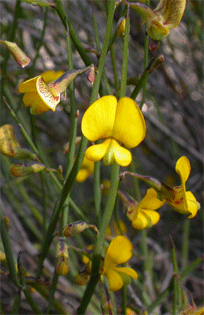|
|
|
|
Bossiaea Vent. 1800 c. 70 spp. Australia (widespread, but not in C Australia) Named for Bossieu de la Martinière, medical officer and botanist accompanying the expedition of La Pérouse on l'Astrolabe which was wrecked near the island of Vanikoro in 1788 Shrubs; tropical, subtropical, mediterranean, temperate and warm temperate forest, woodland, bushland and thicket and shrubland Reference(s): Elliot & Jones (1982, 2: 355 - 362); Stanley & Ross (1983: 266 - 268); Weber (1986: 688 - 691); Wheeler in Marchant et al. (1987: 239 - 242); Ross in Walsh & Entwisle (1996: 808 - 815); various papers by Ross in Muelleria (1991 - 2001); James in Harden (2002: 510 - 516) Allied closely to Platylobium . Flowers subtended by a series of coriaceous or papery brown bracts, mainly insect-pollinated, but in 5 spp. adapted for pollination by birds Foliage toxic to livestock; used as ornamentals © J. H. Ross |  Bossiaea halophila, Lake King, WA |
Bossiaea walkeri , Shark Bay, WA |
Bossiaea ornata, near Albany , WA |
Bossiaea dentata, south coast, WA |
Bossiaea cucullata, Lake King, WA |
Bossiaea preissii, Stirling Range, WA |
|